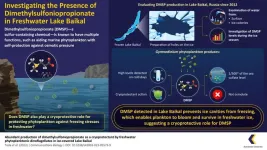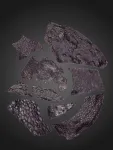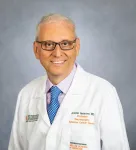(Press-News.org) A new study sheds light on how autophagy, the body’s process for removing damaged cell parts, when impaired, can play a role in causing heart failure. The research team led by Dr. E. Dale Abel, chair of the Department of Medicine at UCLA and Dr. Quanjiang Zhang, adjunct assistant professor of medicine at UCLA, identified a signaling pathway that links autophagy to the control of cellular levels of a key coenzyme known as NAD+, which is found in all living cells and is central to how our metabolism works. Researchers say these findings may have implications for heart failure treatment.
“Heart failure remains a leading cause of mortality and there is a strong need to develop new therapies that can improve cardiac function and increase survival. The identification of a new pathway linking impaired autophagy, a characteristic of heart failure, and increased NAD+ breakdown could open new avenues for therapeutic intervention,” Abel said.
Autophagy is a natural, self-serving mechanism in which the body removes damaged or dysfunctional parts of a cell and recycles their components toward cellular repair or energy production. Abel describes it as our body's cellular recycling system that allows cells to break down bad parts of itself and salvage some of those parts to repurpose into new, usable parts. Given the important role of autophagy in cell breakdown and repair, impaired autophagy is known to cause a range of disorders, including cancer, neurodegeneration and heart failure.
Until now, however, scientists weren't sure what mechanisms underlie mitochondrial and cardiac dysfunction in the setting of impaired autophagy. One proposed mechanism has been the build-up of dysfunctional mitochondria that takes place when autophagy is impaired, as this build-up can activate inflammatory and other responses that can lead to cell death or dysfunction. Another proposed mechanism is the degradation of specific proteins involved in metabolism that reduce the functioning of pathways that regulate heart muscle contraction. The present study identified a new mechanism, namely NAD+ depletion, that leads to heart muscle cell dysfunction in the context of autophagy.
Using a mouse model with autophagy dysfunction in heart cells, the research team found that autophagy regulates the enzyme NNMT, whose levels were increased in this heart failure model. Inhibiting the activity of this enzyme with a small molecule led to an improvement in heart failure even though autophagy failure persisted.
The study elucidated a chain event that explains how and why impaired autophagy can lead to cardiac dysfunction. The first step of this chain is the accumulation of a protein known as SQSTM1. Increased SQSTM1 activates a signaling protein called NF-κB (also known as RELA). NF-κB enters the nucleus and causes increased activity of the gene that encodes the enzyme known as nicotinamide N-methyltransferase (NNMT). NNMT ultimately leads to a breakdown of NAD+ precursors, ultimately lowering NAD+ levels. Low NAD+ levels then cause mitochondrial and cardiac dysfunction.
Unraveling this pathway has linked NAD+ metabolism and autophagy. These findings indicate a new potential therapy for reversing mitochondrial dysfunction and improving heart failure through preventing NAD+ loss and boosting its level in cardiac muscle.
Members of the investigative team included collaborators from the University of Utah, University of Iowa, University of Copenhagen and City of Hope, and supported by grants from the National Institutes of Health, The American Heart Association, the Fraternal Order of Eagles, the Roy J. Carver Trust and the Alfred E. Mann Family Foundation.
This research is published in The EMBO Journal: https://www.embopress.org/journal/14602075
END
Study reveals new connection between impaired autophagy and heart failure
UCLA Health researchers say findings may have implications for heart failure treatment
2024-01-11
ELSE PRESS RELEASES FROM THIS DATE:
Exploring dimethylsulfoniopropionate production by freshwater phytoplankton in lake Baikal
2024-01-11
Phytoplankton or microalgae found in the ocean are often known to produce a sulfur-containing chemical called dimethylsulfoniopropionate (DMSP). This organic molecule breaks down to release a strong but sweet-smelling gas called dimethyl sulfide (DMS), which plays a major role in the formation of cloud condensation nuclei and is also associated with the smell of the sea. More importantly, DMSP acts as an osmolyte and thus protects the phytoplankton against the osmotic pressure created by saline water.
Scientists have, however, ...
Our surprising magnetic galaxy
2024-01-11
A team of astronomers including those from the University of Tokyo created the first-ever map of magnetic field structures within a spiral arm of our Milky Way galaxy. Previous studies on galactic magnetic fields only gave a very general picture, but the new study reveals that magnetic fields in the spiral arms of our galaxy break away from this general picture significantly and are tilted away from the galactic average by a high degree. The findings suggest magnetic fields strongly impact star-forming regions which means they played a part in the creation of our own solar system.
It might come as a surprise to ...
Oldest known fossilized skin is 21 million years older than previous examples
2024-01-11
Researchers have identified a 3D fragment of fossilized skin that is at least 21 million years than previously described skin fossils. The skin, which belonged to an early species of Paleozoic reptile, has a pebbled surface and most closely resembles crocodile skin. It’s the oldest example of preserved epidermis, the outermost layer of skin in terrestrial reptiles, birds, and mammals, which was an important evolutionary adaptation in the transition to life on land. The fossil is described on January 11 in the journal Current Biology along with several other specimens that were collected from the Richards Spur ...
Producing tears in a dish: researchers develop first model of human conjunctiva
2024-01-11
The Organoid group at the Hubrecht Institute produced the first organoid model of the human conjunctiva. These organoids mimic the function of the actual human conjunctiva, a tissue involved in tear production. Using their new model, the researchers discovered a new cell type in this tissue: tuft cells. The tuft cells become more abundant under allergy-like conditions and are therefore likely to play a role in allergies. The organoid model can now be used to test drugs for several diseases affecting the conjunctiva. The study will be published in Cell Stem Cell on 11 January 2024.
Our eyes produce tears to protect themselves from injuries and ...
Palaeontology: New dinosaur species may be closest known relative of Tyrannosaurus rex
2024-01-11
A new species of tyrannosaur from southern North America that may the closest known relative of Tyrannosaurus rex is described in a study published in Scientific Reports.
Sebastian Dalman and colleagues identified the new species — which they have named Tyrannosaurus mcraeensis — by examining a fossilised partial skull, which was previously discovered in the Hall Lake Formation, New Mexico, USA. Although these remains were initially assigned to T. rex and are comparable in size to those of T. rex (which was up to 12 metres long), the authors propose that they belong to a new species due ...
Research shows deadly brain cancer can mimic healthy neurons
2024-01-11
MIAMI, FLORIDA (EMBARGOED UNTIL JAN. 11, 2024, at 11 AM EST) – Certain cancers are more difficult to treat because they contain cells that are highly skilled at evading drugs or our immune systems by disguising themselves as healthy cells.
Glioblastoma, for example, an incurable brain cancer, is characterized by cells that can mimic human neurons, even growing axons and making active connections with healthy brain neurons. This cancer is usually deadly – average survival time is just over one year from diagnosis ...
High-dose radiotherapy with chemotherapy effective in treating people with non-small cell lung cancer
2024-01-11
A new study led by researchers from the UCLA Health Jonsson Comprehensive Cancer Center shows that using high doses of radiation while integrating an ablative radiotherapy technique called stereotactic ablative radiotherapy (SABR) concurrently with chemotherapy is safe and effective in treating people with locally advanced non-small cell lung cancer that is not suitable for surgery.
Based on mid-treatment response, researchers found the combination treatment, which involves a second radiation plan to personalize a boost for the last third of radiation treatments, is a viable and promising option that helps reduce the risk of toxic side effects and having the cancer ...
Synapses brought to the point
2024-01-11
Whether picking up a small object like a pen or coordinating different body parts, the cerebellum in the brain performs essential functions for controlling our movement. Researchers at the Institute of Science and Technology Austria (ISTA) investigated how a crucial set of synapses between neurons within it functions and develops. Their findings have now been published in the journal Neuron.
Even if you do not think about it, every day you are using the intricate circuits of neurons in your brain to perform astonishingly delicate movements with your body. One essential unit in this is the cerebellum playing a key role in fine motor control, coordination, and timing.
“Every ...
Catalytic combo converts CO2 to solid carbon nanofibers
2024-01-11
UPTON, NY—Scientists at the U.S. Department of Energy’s (DOE) Brookhaven National Laboratory and Columbia University have developed a way to convert carbon dioxide (CO2), a potent greenhouse gas, into carbon nanofibers, materials with a wide range of unique properties and many potential long-term uses. Their strategy uses tandem electrochemical and thermochemical reactions run at relatively low temperatures and ambient pressure. As the scientists describe in the journal Nature Catalysis, this approach could successfully lock carbon away in a useful solid form to offset or even achieve negative carbon emissions.
“You can put the carbon nanofibers ...
Substance use disorders among adult cancer survivors
2024-01-11
About The Study: The findings of this study of 6,101 adult cancer survivors suggest that substance use disorder (SUD) prevalence is higher among survivors of certain types of cancer; this information could be used to identify cancer survivors who may benefit from integrated cancer and SUD care. Future efforts to understand and address the needs of adult cancer survivors with comorbid SUD should prioritize cancer populations in which SUD prevalence is high.
Authors: Devon K. Check, Ph.D., of the Duke University School of Medicine in Durham, North Carolina, is the corresponding author.
To access the ...
LAST 30 PRESS RELEASES:
Artificial saliva containing sugarcane protein helps protect the teeth of patients with head and neck cancer
Understanding the role of linear ubiquitination in T-tubule biogenesis
Researchers identify urban atmosphere as primary reservoir of microplastics
World’s oldest arrow poison – 60,000-year-old traces reveal early advanced hunting techniques
Bristol scientists discover early sponges were soft
New study uncovers how rice viruses manipulate plant defenses to protect insect vectors
NSF–DOE Vera C. Rubin Observatory spots record-breaking asteroid in pre-survey observations
Ribosomal engineering creates “super-probiotic” bacteria
This self-powered eye tracker harnesses energy from blinking and is as comfortable as everyday glasses
Adverse prenatal exposures linked to higher rates of mental health issues, brain changes in adolescents
Restoring mitochondria shows promise for treating chronic nerve pain
Nature study identifies a molecular switch that controls transitions between single-celled and multicellular forms
USU chemists' CRISPR discovery could lead to single diagnostic test for COVID, flu, RSV
Early hominins from Morocco reveal an African lineage near the root of Homo sapiens
Small chimps, big risks: What chimps show us about our own behavior
We finally know how the most common types of planets are created
Thirty-year risk of cardiovascular disease among healthy women according to clinical thresholds of lipoprotein(a)
Yoga for opioid withdrawal and autonomic regulation
Gene therapy ‘switch’ may offer non-addictive pain relief
Study shows your genes determine how fast your DNA mutates with age
Common brain parasite can infect your immune cells. Here's why that's probably OK
International experts connect infections and aging through cellular senescence
An AI–DFT integrated framework accelerates materials discovery and design
Twist to reshape, shift to transform: Bilayer structure enables multifunctional imaging
CUNY Graduate Center and its academic partners awarded more than $1M by Google.org to advance statewide AI education through the Empire AI consortium
Mount Sinai Health system receives $8.5 million NIH grant renewal to advance research on long-term outcomes in children with congenital heart disease
Researchers develop treatment for advanced prostate cancer that could eliminate severe side effects
Keck Medicine of USC names Christian Pass chief financial officer
Inflatable fabric robotic arm picks apples
MD Anderson and SOPHiA GENETICS announce strategic collaboration to accelerate AI-driven precision oncology
[Press-News.org] Study reveals new connection between impaired autophagy and heart failureUCLA Health researchers say findings may have implications for heart failure treatment






